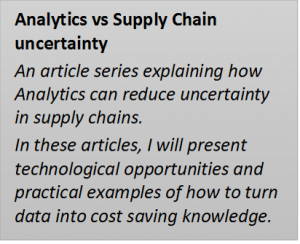 The third article in the series “Analytics vs. Supply Chain Uncertainty deals with predictive analytics – and how it may reduce the uncertainty in your supply chain.
The third article in the series “Analytics vs. Supply Chain Uncertainty deals with predictive analytics – and how it may reduce the uncertainty in your supply chain.
Recalling the two definitions of uncertainty presented in the introduction article to this series, uncertainty is either expressed as doubt during decision-making or non-predictable events.
- Supply chain uncertainty refers to the decision making process in the supply chain in which the decision maker does not know definitely what to decide due to lack of transparency into the supply chain and the impact of possible actions.
- Supply chain uncertainty refers to disruption of the balance and profitability of the supply chain caused by potential and non-predictable events, which requires a response to re-establish the balance.
Predictive Analytics
Following any of these definitions, uncertainty deals with the future and originates in lack of insight. The common response is to apply ones experience in order to analyze uncertainties and select the best possible actions.
Guess what: predictive analytics deals with exactly that. It rests on the assumption that historical and current observations can be used to make predictions about future events; that patterns in explanatory variables can predict the likely outcome for the dependent variable.
It seeks to answer these questions:
- What are the chances of an event occurring some future point in time?
- Should an event occur, what is the impact or amount involved?
Predictive analytics and experience has a lot in common. While experience is important in dealing with uncertainty and should go hand in hand with predictive analytics, the statistical calculations that goes into predictive analytics – has two advantages:
- The amount of observations (data) that can go into the calculations to validate assumed relations or maybe even reveal hidden relations.
- The statistical calculations offer an answer that is more likely to be bias-free – both in terms of the relationship, but also the individual prediction.
Experience takes a long time to build, is limited to one person and may be biased or limited in its view of causes and effects. Predictive models can draw from events prior to the person starting to build experience and can cope with more parameters.
Applying predictive analytics in supply chains
The most commonly used example of how to apply predictive analytics in a supply chain is predictive maintenance. However, this blog will seek to broaden the view and suggest other areas where predictive analytics can provide better insight into the future.
Building a predictive model can be done in any place in the supply chain where you have uncertainties: Upstream, downstream or internally. In principle, a company can investigate any of the uncertainties that drives up material and capacity buffers. Most of the data needed for analysis is already available in the ERP system, so it is just a matter of letting the questions roll. Below are suggestions for dealing with uncertainty by using predictive analytics – related to four different business processes.
In general – instead of calculating KPIs or asking questions about the past – use questions that deal with the future or start with a why or how. Such questions enable real insight into the supply chain uncertainties.
A good predictive model starts with asking the right question.
Limitations
The answer in predictive analytics is a most likely outcome – not a firm answer. It means that even though the predictive model gives an answer, the result may be different. This does not indicate that the model is bad, but that this particular incidence did not follow the most likely scenario. It is just a model – and the model has limitations.
It can be hard to accept that once you have set up a predictive model to give you certainty – it will sometimes fail to give you a correct answer. In the long run, the model should however help you to predict the future and thereby reduce the uncertainties you face – and increase the likelihood of making the right decisions at the right time.
The cultural barrier
There is not a wide tradition of using analytics to deal with supply chain problems. When running a supply chain, data and analytics are not core business – running the supply chain is. This means that uncertainties are dealt with using the traditional approaches and cost added to cope with uncertainties are accepted as necessary.
However, as digitalization grows, so does the awareness that data can - and will answer more and more questions. Also – we see that it does however start with asking the right questions – adding data and analytics and understanding the answer.
This means going beyond traditional KPIs and reporting. More on this in the next blog.
Previous posts on this series:
Analytics vs supply chain uncertainty I - introduction
Getting rid of “the living dead” stock with advanced analytics

